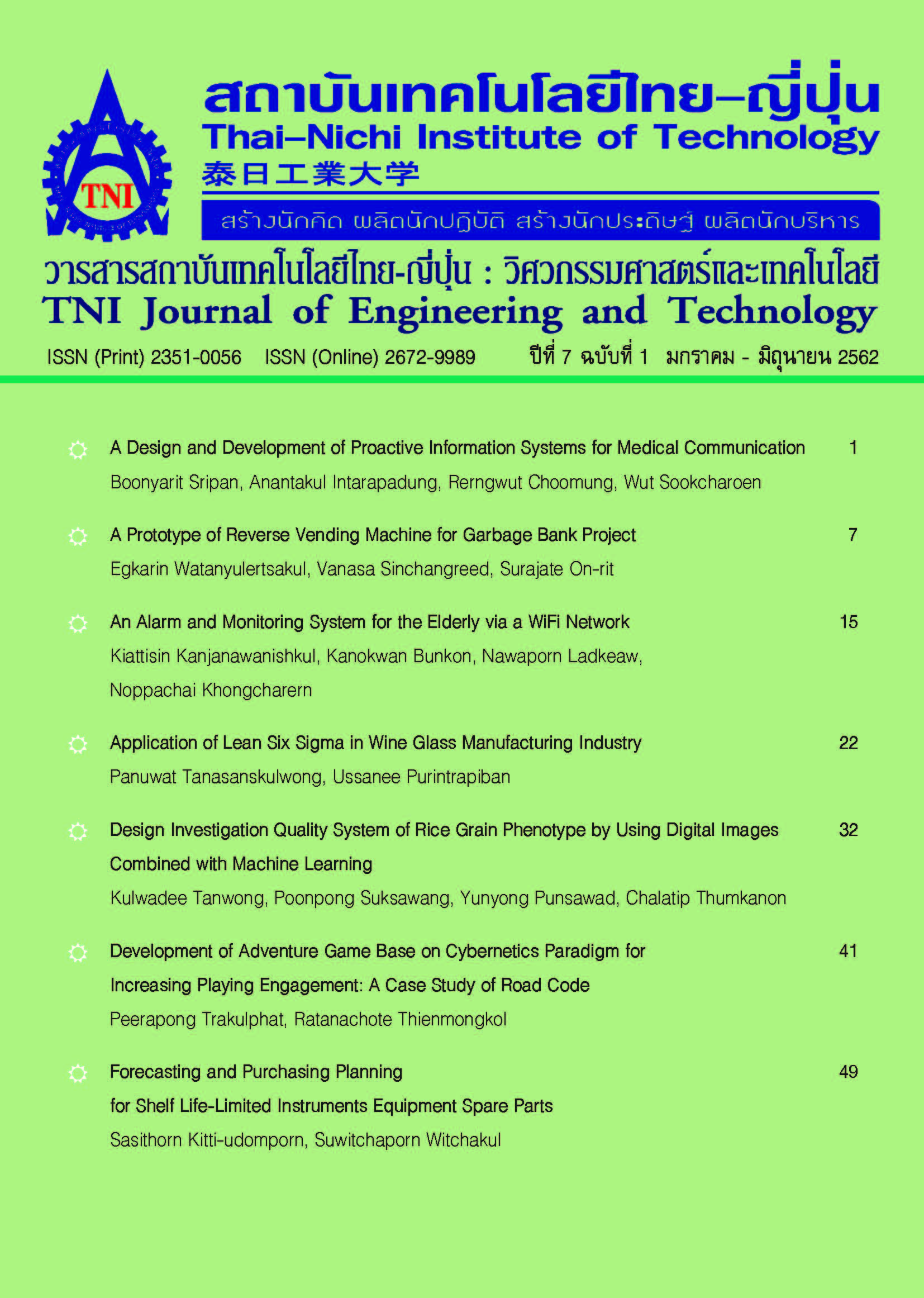Strategic Approach to Adopt ICT in SMEs
Main Article Content
Abstract
This study investigates the success and failure factors of ICT adoption and usage in Thailand and Japan. In addition, this research aims to establish, derive and come up with an indicative model of identified factors and framework related to successfulness in ICT adoption in SMEs. The factors affecting the risks of ICT adoption faced by SMEs organization consists of three predictors: risk assessment, clear scope of the ICT project and internal management response to project. Finding factors will help the project team estimate the effectiveness of current controls and suggests whether each ICT adoption and usage is potentially failed, potentially succeed, or potentially over-controlled.
Article Details
Article Accepting Policy
The editorial board of Thai-Nichi Institute of Technology is pleased to receive articles from lecturers and experts in the fields of business administration, languages, engineering and technology written in Thai or English. The academic work submitted for publication must not be published in any other publication before and must not be under consideration of other journal submissions. Therefore, those interested in participating in the dissemination of work and knowledge can submit their article to the editorial board for further submission to the screening committee to consider publishing in the journal. The articles that can be published include solely research articles. Interested persons can prepare their articles by reviewing recommendations for article authors.
Copyright infringement is solely the responsibility of the author(s) of the article. Articles that have been published must be screened and reviewed for quality from qualified experts approved by the editorial board.
The text that appears within each article published in this research journal is a personal opinion of each author, nothing related to Thai-Nichi Institute of Technology, and other faculty members in the institution in any way. Responsibilities and accuracy for the content of each article are owned by each author. If there is any mistake, each author will be responsible for his/her own article(s).
The editorial board reserves the right not to bring any content, views or comments of articles in the Journal of Thai-Nichi Institute of Technology to publish before receiving permission from the authorized author(s) in writing. The published work is the copyright of the Journal of Thai-Nichi Institute of Technology.
References
J. Eaempoom and A, Tangviroon, “SMEs Statistic in Thailand,” Bank of Thailand, [Online]. Available: https://www.bot.or.th/Thai/Statistics/Articles/DocLib_StatinFocus/SMEs.pdf [Accessed: 22-May-2018].
OSMEP Thailand, “E-BUSINESS AND SMEs,” [Online]. Available: https://www.oecd.org/cfe/smes/31919255.pdf [Accessed: 2-May-2018].
G. K. Winley and S. Nontakao, “Factors Affecting the Success of Enterprise Resource Planning Systems in Thailand,” Science, Engineering and Health Studies, vol. 9, No. 2, pp. 20-39, 2015.
J. A. Keizer, L. Dijkstra, and J. I. M. Halman, “Explaining innovative efforts of SMEs.: An exploratory survey among SMEs in the mechanical and electrical engineering sector in The Netherlands,” Technovation, vol. 22, no. 1, pp. 1–13, Jan. 2002.
D. Peter F., Innovation and entrepreneurship. London: Routledge, 2015.
Organisation For Economic Co-operation And Development, “ICT,E-BUSINESS AND SMEs,” in Promoting entrepreneurship and innovative SMEs in a global economy: towards a more responsible and inclusive globalization, Istanbul, Turkey, 2004.
A. Jaafari, and K. Manivong, “Towards a smart project management information system,” International journal of project management, Vol. 16 no. 4, pp. 249-265, 1998.
C. Bredillet, F. Yatim, and P. Ruiz, “Project management deployment: The role of cultural factors,” International Journal of Project Management, Vol. 28, No. 2, pp. 183-193, 2010.
T. Ramayah, N.S. Ling, S.K. Taghizadeh and S.A. Rahman, “Factors influencing SMEs website continuance intention in Malaysia,” Telematics and Informatics, Vol. 33, No. 1, pp. 150-164 , 2016.
A. Tovar, “SME Technology attitudes and beliefs: An exploratory study of information technology adoption behavior,” Ph.D. dissertation (Information Systems and Technology), University of Phoenix, Phoenix, United States, 2012.
A. De Wit, “Measurement of project success,” International journal of project management, Vol.6, No. 3, pp.164-170, 1988.
A.K. Munns, and B.F. Bjeirmi, “The role of project management in achieving project success,” International journal of project management, Vol.14, No. 2, pp. 81-87, 1996.
R. Turner, A. Ledwith and J. Kelly, “Project management in small to medium-sized enterprises: Matching processes to the nature of the firm,” International journal of project management, Vol. 28, No. 8, pp. 744-755, 2010.
K. De Bakker, A. Boonstra and H. Wortmann, “Does risk management contribute to IT project success? A meta-analysis of empirical evidence,” International Journal of Project Management, Vol. 28, No. 5, pp. 493-503, 2010.
X. Xin. "Document Management in Project Development," in 4th International Conference on Education, Management, Arts, Economics and Social Science (ICEMAESS 2017), Sanya, China, 2017.
F. Hartman and R. Ashrafi, “Development of the SMARTTM Project Planning framework,” International Journal of Project Management, Vol. 22 No. 6, pp. 499-510, 2004.
Paragon, “10 Benefits of working with an IT consultant.” [Online]. Available: https://www. paragon.net/benefits-it-consultant [Accessed: 22-May-2018].
B. M. Sadowski, “Advanced users and the adoption of high speed broadband: Results of a living lab study in the Netherlands,” Technological Forecasting and Social Change, vol. 115, pp. 1–14, Feb. 2017.
B. R. Eichhorn, “The impact of user involvement on information system projects.” [Online]. Available: https://etd.ohiolink.edu/!etd.send_file?accession= csu1410793063&disposition=inline [Accessed: 20-May-2018].
M. A. Harris, and H.R. Weistrofferv, “A new look at the relationship between user involvement in systems development and system success,” Communications of the Association for Information Systems, Vol. 24, No. 1, pp. 739-756, 2009.
J. W. Creswell, Research Design: Qualitative, Quantitative and Mixed Methods Approaches, 4th ed. Thousand Oaks: SAGE Publications, 2014.
H. F. Kaiser, “The varimax criterion for analytic rotation in factor analysis,” Psychometrika, vol. 23, no. 3, pp. 187–200, Sep. 1958.
IBM, “IBM SPSS Modeller 17 Algorithms Guide.” [Online]. Available: htttp://public.dhe.ibm.com/software/analytics/spss/documentation/modeler/17.0/en/AlgorithmsGuide.pdf. [Accessed: 22-May-2018].

